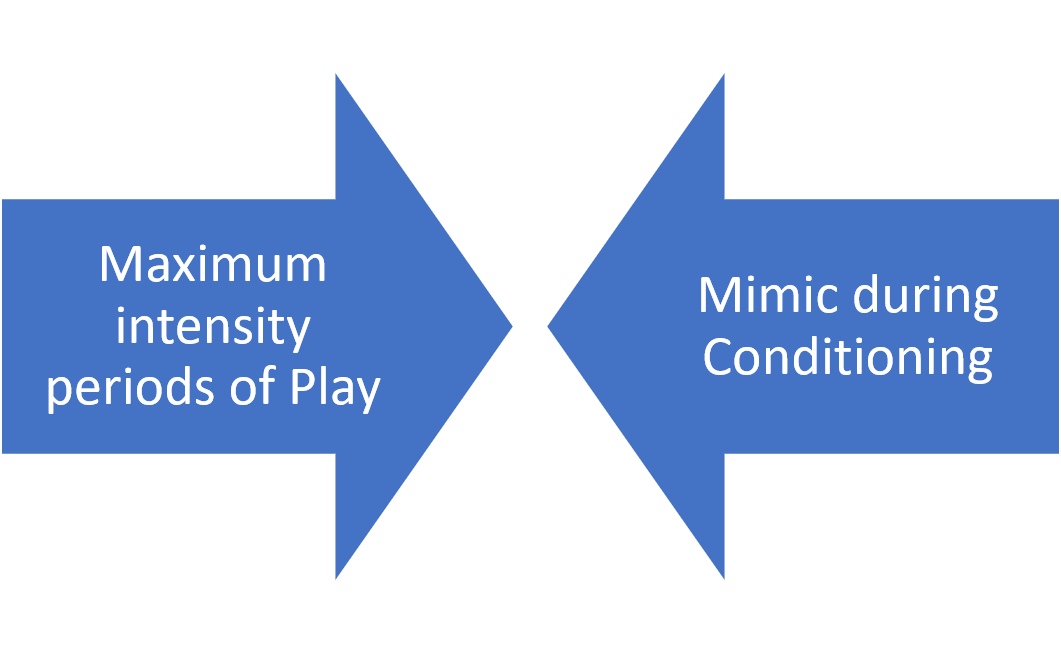High intensity passages of play
On reviewing the research around demands of the game, an interesting consideration arises. Many research papers and articles on the demands of the game report the mean or average demands of the game when discussing the running demands or the collision demands etc. This is great for giving the coach an overall picture of the physiological stress that a player will be exposed to on the field of play. However, if the coach just relies on the mean data from the whole game, the periods of maximal intensity during the game may be drastically underestimated. If the coach only uses average whole game data to guide their conditioning training, then this could lead to players being underprepared for the most physically intense periods of the game. This under preparation of players is far from optimal, as quite often the most intense periods in a game are important decisive passages of play with regards to the result. Therefore, the coach needs to consider the maximal intensity passage of play in a game as the upper level of the demands that will be placed on the player, and this will help guide the conditioning training.
Figure 5. Summary of ball in play time. Data from Male Academy level match-play (Read et all 2019).

Read and colleagues in 2019 looked at maximal running intensities during English Academy match play. They examined the periods of maximal running intensities during the game using different time periods; 15 sec, 30 sec, 1 min, 2 min, 2.5 min, 3 min, 4 min, 5 min and 10 min (for example the 10 minute period of the whole game where the player had the highest running intensity or the 30 second period of the game where the player had the highest running intensity). These time periods are valuable to coaches as they cover both the mean (roughly 30 sec) and maximal (roughly 2.5 min) ball in play time periods in academy rugby. These time periods also match well with common conditioning training time periods (30 seconds for short bouts or 2-4 minutes for longer bouts). They found that as the period of measurement increased, the maximal running intensity decreased across all positions. There were clear decreases in running intensity between each time point in the study. For example, the inside backs 15 second maximal running intensity period of the game was on average 297 m/min. If the time was extended to the most intense 30 second period of the game, the maximal running intensity was on average 245 m/min. If we look at the longest timepoint for maximal running intensity which was the 10-minute average, the inside backs maximal running intensity drops to 92 m/min. So if a coach looked at research that said the maximal running intensity of an inside back in a game was 92 m/min because they used a 10 minute average period in the study, then the coach may assume that this is the upper level of conditioning that an inside back needs. However, this is less than half of the intensity that they will experience in the hardest 30 seconds of the game and so there is the danger that they will be unprepared physically and performance would suffer.
Figure 6. As the duration of play increases, maximum running speed decreases.

Flanagan and colleagues in 2017 looking at elite junior rugby players, examined the average whole game locomotor demands and the 5-minute period of maximal intensity during the game. The 5-minute period of maximal intensity was defined as the 5-minute period with the greatest high metabolic load distance covered. They found that the relative distance measured in meters per minute was 33-48 % greater in the 5-minute maximal intensity period compared to the relative distance covered over the whole game. They also reported that during the 5-minute period of maximal intensity, the percentage of time that players were covering high metabolic load distances was 70-90 % greater than the percentage of time high metabolic load distances were covered during the game as a whole. This information shows that the 5-minute period of maximal intensity during the game was much more challenging than the intensity averaged out over the course of the whole game. Coaches looking to maximise performance should take periods of maximal intensity into account during their conditioning training so their players will have experienced these demands in training before they occur on the field during a game.
Figure 7. Conditioning should seek to replicate the highest intensity periods of play.
